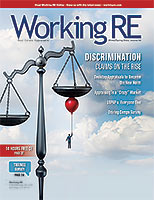 |
“One of the best courses that I have had in 17 years!” -Amy H
> OREP E&O |
Editor’s Note: Share your experience with trainees in Working RE’s Survey for Trainee Supervisors and help the entire industry. Take the four-minute survey now.
Appraising in a “Crazy” Market
by Isaac Peck, Editor
In mid-2021, Freddie Mac published an article titled “Appraising in a Rapidly Changing Market,” authored by Scott Reuter, Freddie Mac’s Single-Family Chief Appraisal Officer.
The article piqued my interest for a number of reasons, chief among them being that the article points out that between 2013 through 2019, the “annual average” of appraisals which came in below contract price was between seven and nine percent. In April and May of 2021, the number of appraisals coming in below contract price had risen to 20 percent.
That’s a pretty stark increase. Such a stark increase, in fact, that Freddie Mac thought it was worth publishing an article addressing how appraisers can “keep up with the market.”
The reason this is so interesting to me is that I’ve attended several national conferences, over the last five years especially, where executives from Fannie Mae and Freddie Mac (the GSEs) have openly chided appraisers about “anchoring” and “contract price confirmation bias.” These criticisms are usually voiced over PowerPoint slides depicting bell curves and cute “anchoring” graphics that show how the appraised value changes when the contract price is known to the appraiser.
When contrasted with the previous anchoring criticism leveled against appraisers by the GSEs, could this be a positive indication? A sign that appraisers are not just rubber stamping values after all—but instead are acting with integrity and thinking for themselves?
Fast, Fast, Fast
One of the key points that Reuter makes is that the market has been moving so fast that it makes it difficult for appraisers to capture the market’s rate of growth if they are not paying very close attention to pending sales and making time adjustments, even for time periods as short as 15 or 30 days.
“In many cases, closed sales aren’t keeping up with contract prices because the meeting of the minds that happened on a closed sale might’ve happened one, two or even three months before the sale actually closes. In other words, by the time a sale closes, the market has likely already moved substantially. This is especially true in a market that is moving 18 to 20 percent per year. 18% in one year equates to 1.5% per month,” says Reuter.
The hope is that this is causing appraisers to see time or market condition adjustments in a whole new light. In other words, the use of adjustments is now becoming necessary in shorter and shorter periods of time. “A lot of appraisers are still saying that they won’t adjust a comparable if it’s only a few months old. However, with the market changing so rapidly it is clear that closed sales transactions are lagging. We’ve really been trying to drive that point home in our messaging to appraisers,” reports Reuter.
(story continues below)
(story continues)
Reuter says it is noteworthy that only one in four appraisers are actually developing and applying time or market condition adjustments. “To not be considering a time adjustment in today’s market is concerning. We know appraisers are busy; we know there’s a capacity strain on appraisers. Appraisers have to deal with a lot. But there is a strong need to slow down just a bit and make sure we’re really doing the appropriate analysis when we put these appraisals out,” argues Reuter.
Also keeping your bearings in a “crazy” market involves more than just making time adjustments, according to Reuter. “Appraisers also need to look for other indicators—more current indicators—that can help them develop value in a rapidly changing market. One of my family members just bought a house in West Lafayette, Indiana. On their first day in the car to see homes for sale, they went to see four homes, and two of the homes sold while they were driving to go see them. So appraisers need to look at all property type movements, including what the general inventory supply and price movement is, what are the market conditions, and how fast is the market moving,” Reuter says.
With closed sale transactions lagging current trends, Reuter advises appraisers to look at all market behavior, not just the behavior reflected by closed sales.
These sources of information include:
• General market inventory
• Trends in listing prices
• Contract-to-listing ratio (pending sales)
• Contract dates vs closed dates (market change)
• Exposure time and marketing time
• New construction patterns
• Number of available competing properties
Trends derived from such sources can provide valuable augmentation to the closed sales data, according to Reuter.
Another recommendation that Reuter has for appraisers is to consider whether market conditions make it more appropriate to reconcile near the top of the indicated value range rather than at the midpoint. “This is another area where our review data shows a common behavior for appraisers to typically reconcile at or near a mid-point value indication, regardless of current market trends,” writes Reuter in his original article.
When asked about a criticism of appraisers anchoring on contract price, Reuter points out that the contract price is a very important data point. “Many appraisers put a lot of weight on the contract price and rightly so. It is a data point and it should be considered as it represents a meeting of the minds in the marketplace,” says Reuter.
To read Freddie Mac’s original Article, visit WorkingRE.com/rapidmarket/. Stay safe out there!
About the Author
Isaac Peck is the Editor of Working RE magazine and the President of OREP, a leading provider of E&O insurance for real estate professionals. OREP serves over 10,000 appraisers with comprehensive E&O coverage, competitive rates, and 14 hours of CE at no charge for OREP Members (CE not approved in IL, MN, GA). Visit OREP.org to learn more. Reach Isaac at isaac@orep.org or (888) 347-5273. Calif. Lic. #4116465.
Tips for Smoother Appraising
CE Online – 7 Hours (45 states)
How to Support and Prove Your Adjustments
Presented by: Richard Hagar, SRA
Must-know business practices for all appraisers working today. Ensure proper support for your adjustments. Making defensible adjustments is the first step in becoming a “Tier One” appraiser, who earns more, enjoys the best assignments and suffers fewer snags and callbacks. Up your game, avoid time-consuming callbacks and earn approved CE today!
Sign Up Now! $119 (7 Hrs)
OREP Members: Save 10%
>Opt-In to Working RE Newsletters
>Shop Appraiser Insurance
>Shop Real Estate Agent
Insurance
Send your story submission/idea to the Editor:
isaac@orep.org



